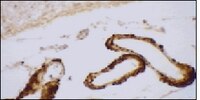NE1004 Sigma-AldrichAnti-Apolipoprotein E Mouse mAb (E6D7)
Anti-Apolipoprotein E, mouse monoclonal, clone E6D7, recognizes the ~35 kDa Apo E2, E3, and E4 in human serum and brain. It is validated for ELISA, WB, IP, and paraffin and frozen sections.
More>> Anti-Apolipoprotein E, mouse monoclonal, clone E6D7, recognizes the ~35 kDa Apo E2, E3, and E4 in human serum and brain. It is validated for ELISA, WB, IP, and paraffin and frozen sections. Less<<Synonyms: Anti-ApoE
Recommended Products
Overview
| Replacement Information |
|---|
Key Specifications Table
| Species Reactivity | Host | Antibody Type |
|---|---|---|
| H | M | Monoclonal Antibody |
Products
| Catalog Number | Packaging | Qty/Pack | |
|---|---|---|---|
| NE1004-100UL | Plastic ampoule | 100 ul |
| References | |
|---|---|
| References | Golabek, A.A., et al. 1996. J. Biol. Chem. 271, 10602. |
| Product Information | |
|---|---|
| Form | Liquid |
| Formulation | Culture supernatant diluted in PBS. |
| Positive control | Brain tissue, serum |
| Preservative | None |
| Quality Level | MQ100 |
| Physicochemical Information |
|---|
| Dimensions |
|---|
| Materials Information |
|---|
| Toxicological Information |
|---|
| Safety Information according to GHS |
|---|
| Safety Information |
|---|
| Product Usage Statements |
|---|
| Packaging Information |
|---|
| Transport Information |
|---|
| Supplemental Information |
|---|
| Specifications |
|---|
| Global Trade Item Number | |
|---|---|
| Catalog Number | GTIN |
| NE1004-100UL | 04055977209839 |
Documentation
Anti-Apolipoprotein E Mouse mAb (E6D7) SDS
| Title |
|---|
Anti-Apolipoprotein E Mouse mAb (E6D7) Certificates of Analysis
| Title | Lot Number |
|---|---|
| NE1004 |
References
| Reference overview |
|---|
| Golabek, A.A., et al. 1996. J. Biol. Chem. 271, 10602. |



















